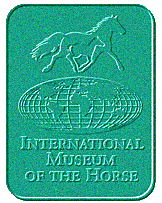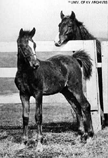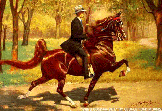

Table of Contents
 Ponies are frequently seen grazing on the farms near coal mines. Most of these rugged little ponies are descendants of pit ponies
which were used to haul coal from mines as early as the 1600s.
Ponies are frequently seen grazing on the farms near coal mines. Most of these rugged little ponies are descendants of pit ponies
which were used to haul coal from mines as early as the 1600s.
When coal was first mined in America, breeds such as the hearty Shetland ponies from northern Scotland were imported in great numbers to work in the mines of Pennsylvania, Ohio, West Virginia, and Kentucky.
The Dark Work of the Hard Working Little Mine Ponies
Life in the coal mines has never been easy for either man or beast. But few equines have received better care and respect than
the pit pony. In some larger mines - particularly in Europe - a pony would be bred, born, and put to work without ever having
seen the light of the sun. Whether this confinement was insensitive or really more humane has been debated for some time.
However, a pony in the mines received excellent care and attention throughout its working life.
 Those who knew Man o' War were enriched by the experience. This was not just another racehorse. Man o' War was one
of 1,680 Thoroughbreds foaled in 1917. He was born on March 29 at the Kentucky Nursery Stud owned by August
Belmont II. Man o' War's sire was Fair Play, by Hastings, both of whom were mean and temperamental, but excellent
weight carriers. To provide balance to Fair Play's temper, Belmont bred him to Mahubah, by Rock Sand who had won
the British Triple Crown.
Those who knew Man o' War were enriched by the experience. This was not just another racehorse. Man o' War was one
of 1,680 Thoroughbreds foaled in 1917. He was born on March 29 at the Kentucky Nursery Stud owned by August
Belmont II. Man o' War's sire was Fair Play, by Hastings, both of whom were mean and temperamental, but excellent
weight carriers. To provide balance to Fair Play's temper, Belmont bred him to Mahubah, by Rock Sand who had won
the British Triple Crown.
Her ancestors were even tempered and intelligent. He was named by Mrs. Belmont, "My Man o' War"-since he
was a war baby. Belmont's insight as a breeder ultimately paid off, if not in money. Belmont was to serve in the Army in 1918,
so he ordered his entire crop of yearlings sold at Saratoga.
 At Saratoga, Man o' War was bought by Pennsylvania horseman Samuel Riddle for $5,000. Riddle reasoned that if the big,
chestnut yearling didn't succeed as a race horse, he could perhaps be trained a show jumper. The horse was shipped to
Riddle's training farm, "Glen Riddle, " in Maryland. Man o' War was trained by Louis Feustel who had trained
Mahubah, Fair Play, and Hastings. Here Man o' War grew to the size and name of "Big Red."
At Saratoga, Man o' War was bought by Pennsylvania horseman Samuel Riddle for $5,000. Riddle reasoned that if the big,
chestnut yearling didn't succeed as a race horse, he could perhaps be trained a show jumper. The horse was shipped to
Riddle's training farm, "Glen Riddle, " in Maryland. Man o' War was trained by Louis Feustel who had trained
Mahubah, Fair Play, and Hastings. Here Man o' War grew to the size and name of "Big Red."
When he was sent off to his first race at Belmont Park, a retired bay hunter named Major Treat accompanied him and would
continue to travel with Man o' War throughout his racing career.
 On June 6, 1919, ridden by Johnny Loftus, Man o' War won his first race by six lengths, crossing the finish line at a canter. He
showed his desire to be a front runner and never liked to have any other horse in front of him. Legend has it that upon seeing
him in action, a spectator asked a groom, "Who's he by?" The reply was "He's by hisself, and there ain't
nobody gonna get near him." He ran only in expensive stake races for the remainder of his career. As his wins built up,
so did the weight he was required to carry. By his fourth race, Man o' War was carrying 130 pounds, a very great weight for a
two-year-old.
On June 6, 1919, ridden by Johnny Loftus, Man o' War won his first race by six lengths, crossing the finish line at a canter. He
showed his desire to be a front runner and never liked to have any other horse in front of him. Legend has it that upon seeing
him in action, a spectator asked a groom, "Who's he by?" The reply was "He's by hisself, and there ain't
nobody gonna get near him." He ran only in expensive stake races for the remainder of his career. As his wins built up,
so did the weight he was required to carry. By his fourth race, Man o' War was carrying 130 pounds, a very great weight for a
two-year-old.
His sixth race was the Sanford Memorial and the only defeat of his career. A bad start left him with a ten length deficit, and once he caught the pack he was boxed in. He was beaten by a horse ironically named Upset, whom Man o' War beat on six other occasions. In spite of this lone defeat, at the end of his two-year-old season he was selected Horse of the Year.
 Man o' War went undefeated as a three-year-old in 1920, and reduced the American record for the mile by two-fifths of
a second, to 1:35 4/5; and even at that, his jockey - now Clarence Kummer - had held him back. Later, in the Belmont
Stakes, he went 1 3/8 in 2:14 1/4 which stood for 50 years. By the time of the Dwyer Stakes at Aqueduct, Man o' War
could find only one opponent, John P. Grier, a horse from the Whitney Stables. In this race, Grier challenged Man o' War,
and Kummer used his whip for the first time. Man o' War dashed to victory, and set a new American record at 1:45 1/5.
Man o' War went undefeated as a three-year-old in 1920, and reduced the American record for the mile by two-fifths of
a second, to 1:35 4/5; and even at that, his jockey - now Clarence Kummer - had held him back. Later, in the Belmont
Stakes, he went 1 3/8 in 2:14 1/4 which stood for 50 years. By the time of the Dwyer Stakes at Aqueduct, Man o' War
could find only one opponent, John P. Grier, a horse from the Whitney Stables. In this race, Grier challenged Man o' War,
and Kummer used his whip for the first time. Man o' War dashed to victory, and set a new American record at 1:45 1/5.
The crowning event of Man o' War's career came in a match race against the celebrated Canadian horse Sir Barton, the first winner of the Triple Crown. On October 12, 1920, he and Man o' War met in Windsor, Ontario. Man o' War won by seven lengths! In his career "Big Red" won 20 of 21 races.
 Watch a segment of Man o' War's famous match race with Sir Barton.
Watch a segment of Man o' War's famous match race with Sir Barton.
Note: 3.53 meg. AVI file.
His funeral was broadcast over radio and covered by the press all over the world. Samuel Riddle had commissioned Herbert Hazeltine to sculpt a memorial statue of Big Red while he lived, to be placed on his grave. In 1977 Man o' War and his famous statue were brought to the Kentucky Horse Park. Here at the end of the entrance drive, he continues to greet horse fans from all over the world.
 One Saddle Horse which became a legend in his own time was the great Wing Commander. Foaled in 1943,
Wing Commander was by Anacacho Shamrock and out of Flirtation Walk. He was a model of everything a Saddle Horse
should be. He was bred and owned by Dodge Stables (at Castleton Farm, only a mile from the Kentucky Horse Park).
One Saddle Horse which became a legend in his own time was the great Wing Commander. Foaled in 1943,
Wing Commander was by Anacacho Shamrock and out of Flirtation Walk. He was a model of everything a Saddle Horse
should be. He was bred and owned by Dodge Stables (at Castleton Farm, only a mile from the Kentucky Horse Park).
Wing Commander was trained and shown by Earl Teater, one of the outstanding trainer-riders in the Saddle Horse world.
In 1946, he was first entered in competition as a five-gaited stallion and began a career of consistent victories over the finest
Saddle Horses in the country. At the Kentucky State Fair in 1948, Wing Commander won the Five-gaited World's Grand
Championship, and continued to win this championship every year until he was ten years old in 1953. Retired to stud at
Castleton Farm, Wing Commander earned a reputation as a prepotent sire of champion Saddle Horses.
 When the German Panzer divisions crossed the Polish border in 1939, they confronted an adversary which symbolized the end of
the mounted soldier - or so they thought. Pathetically, the Polish Cavalry attempted to stall the invasion by charging the German
tanks on horseback. To say the least, the valiant Poles were quickly overrun. Four years later the cavalry had a final say.
In the cold winter of 1943, on the steppes of the Ukraine, the German tanks were literally frozen in their tracks. Cossacks
descended on the tanks, mounted on ponies which were descendants of the horses of the ancient Scythians, the first masters of
cavalry.
When the German Panzer divisions crossed the Polish border in 1939, they confronted an adversary which symbolized the end of
the mounted soldier - or so they thought. Pathetically, the Polish Cavalry attempted to stall the invasion by charging the German
tanks on horseback. To say the least, the valiant Poles were quickly overrun. Four years later the cavalry had a final say.
In the cold winter of 1943, on the steppes of the Ukraine, the German tanks were literally frozen in their tracks. Cossacks
descended on the tanks, mounted on ponies which were descendants of the horses of the ancient Scythians, the first masters of
cavalry.
The Cossacks swept over the frozen plain firing machine guns and throwing grenades into the German forces with deadly effect.
The Cossacks fled on their swift horses before the astonished Germans had time to react.
Next Exhibit - The Horse in Sport